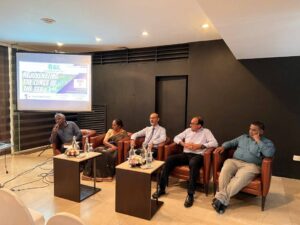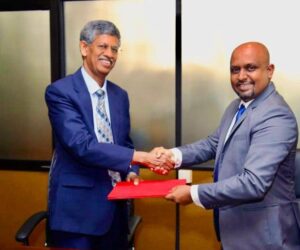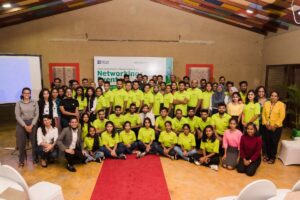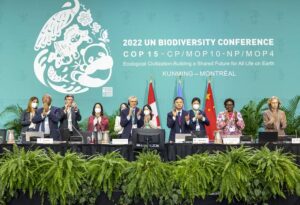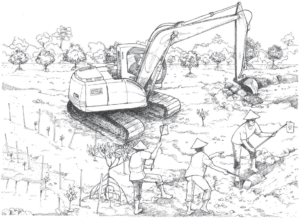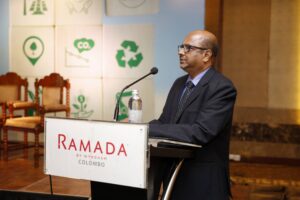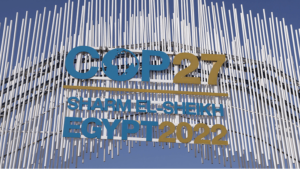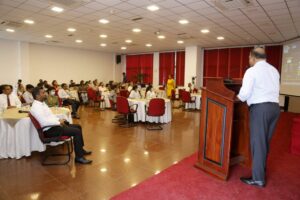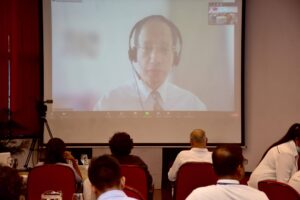Working to Protect the Environment in Armed Conflict
(Measuring depleted uranium contamination with gamma meter. Djakovica, Kosovo.)
Protecting the environment in times of armed conflict is not a new idea. Even in ancient times, rules existed to ensure that natural resources essential for people’s survival, such as clean water, were protected. Unfortunately, the need to protect the environment in the context of armed conflict is more urgent today than ever before. Observing the International Day for Preventing the Exploitation of the Environment in War and Armed Conflict — which falls on this Sunday, November 6 — is a way of recognizing and striving to address the impacts of war on the environment.
During the 1900s, technological developments in weaponry carried with them unprecedented threats to and effects on the environment. In addition to the risks presented by conventional means and methods of warfare, environmental damage in connection with the testing or use of nuclear weapons loomed. The long-lasting effects of such testing became particularly visible to me when I visited the Marshall Islands earlier this year, as did the effects of remnants of war at sea for the small island states in the Pacific.
From the Vietnam War in the 1970s to the Iraq-Kuwait war in the 1990s, awareness of the environmental risks and damage grew slowly but surely. Many of us remember the shocking images of environmental destruction, such as “Agent Orange” in Vietnam or the burning oil wells in in Kuwait. In Kuwait, approximately 600 oil wells were set on fire, with some wells burning for more than eight months and causing severe damage to the environment in their wake. Iraqi areas and lands were also affected by the warfare. The efforts of Dr Mishkat Al-Moumin, Iraq’s first Minister of Environment, were critical in establishing governance structures for environmental protection in Iraq during her tenure in 2004–2005.
The burning of oil wells and other environmentally disastrous effects of the war once again awoke the international community to the effects of modern warfare on the environment. Similarly, more recent conflicts in the Former Republic of Yugoslavia, Kosovo, Iraq, Sierra Leone, Lebanon and Liberia all demonstrated the high environmental costs for war-torn societies.
(Spilled mercury in Pancevo, Serbia.)
In stride with the advances in warfare technology, the 1970s saw the birth of modern international environmental law, in particular through the Stockholm Declaration on the Protection of the Environment, concluded in 1972 at the United Nations Conference on the Human Environment. This conference also led to the establishment of the United Nations Environment Programme (UN Environment).
The environmental concerns raised in the wake of the Vietnam War and subsequent to the 1972 Stockholm Declaration were reflected in two important legal documents, namely the Convention on the Prohibition of Military or Any Other Hostile Use of Environmental Modification Techniques (ENMOD, 1976) and the First Additional Protocol to the Geneva Conventions (1977). Attempts to further codify and strengthen the protection of the environment during armed conflict were made in the aftermath of the Iraq-Kuwait war in the 1990s. The United Nations General Assembly discussed the matter, resolutions were adopted but in the end these attempts failed to arrive at any new legally binding protection measures.
However, one important and lasting result was the International Committee of the Red Cross and Red Crescent (ICRC) Guidelines for Military Manuals and Instructions on the Protection of the Environment in Times of Armed Conflict. Without formally approving these guidelines, the United Nations General Assembly invited all States to “give due consideration to the possibility of incorporating them into their military manuals and other instructions addressed to their military personnel” at its 49th session in 1994. The Guidelines were a recognition of the need to address the protection of the environment in operational terms.
(Remnants of war in Sudan.)
In 2009, UN Environment, the ICRC and the Environmental Law Institute made one of the first comprehensive analyses of how the many different areas of international law could protect the environment during armed conflict. This analysis examined not only international humanitarian law, but also environmental law, human rights law and international criminal law. It presented twelve recommendations available in the publication: “Protecting the environment during armed conflict: An Inventory and Analysis of International Law”.
Among the recommendations in the 2009 UN Environment report, the United Nations International Law Commission (ILC) was recommended to “examine the existing international law for protecting the environment during armed conflict and recommend how it can be clarified, codified and expanded”. Partly due to the fact that the recommendation came from another United Nations entity, the ILC examined it and as a result considered it apt for being placed on its long-term program of work in 2011. In 2013 the topic “Protection of the environment in relation to armed conflicts” was placed on the current program of work and I was honoured to be appointed Special Rapporteur for the topic.
The International Law Commission, set up in 1947, consists of 34 legal experts representing the principal legal systems of the world, that report to the General Assembly on topics where it identifies a need to codify or progressively develop international law. Over the years, the Commission has addressed topics such as the law of the sea, treaty law, international criminal law, and protecting persons in the event of disasters.

After having placed the topic Protection of the environment in relation to armed conflicts on the agenda our first challenge was how to deal with such a complex topic. The Commission decided to structure the topic into three temporal phases in order to examine the legal rules applicable before, during, and after the armed conflict. In my capacity as Special Rapporteur, I have presented the Commission with three reports that address the three temporal phases. The Commission has considered all three reports and as a result a set of draft ‘principles’ have been outlined. These principles gather existing obligations under international law, addressing gaps and allowing the Commission to provide a holistic set of draft principles to be considered by the General Assembly. The principles do not aim at re-writing the present law of armed conflict, but rather focus on preventive and post-conflict measures.
The principles include the need for post-conflict environmental assessments and remedial measures, the sharing and granting of access to information, to name just a few. They also address the environmental impact of peace operations, as well as the need to address matters relating to the restoration and protection of the environment damaged by an armed conflict in peace processes. The need to remove or render harmless toxic and hazardous remnants of war on land and in the sea is recognized, as is the important role of relevant international organizations.

In addition, the principles also encourage the establishment of protecting zones of major environmental and cultural interest. As we know, these areas can have a critical importance, both for protecting fragile ecosystems, and for ensuring the rights of local communities and indigenous peoples.
The work in the Commission is on-going and it is encouraging to note that our efforts come at a critical time, when concurrent efforts from other organizations are emerging. For instance, the ICRC guidelines are currently being revised to better reflect the developments since 1994. Indeed, one of the recommendations of the 2009 UN Environment report addressed the need to update the ICRC Guidelines, for instance to define key terms and examine protection of the environment during non-international armed conflicts. This suggestion and other recommendations were given further momentum by the fact that the 2011 ICRC report on Report on strengthening legal protection of victims of armed conflicts recognized environmental protection as one of the four areas of international humanitarian law that needed to be reinforced. That same year, Nordic countries issued a pledge on protection of the natural environment in times of armed conflicts at the 31st International Conference of the Red Cross and Red Crescent.
In addition, the resolution on the protection of the environment in areas affected by armed conflicts agreed by consensus at the United Nations Environment Assembly (UNEA-2) in May this year was a major signal of the commitment of United Nations Member States to confront the issue.

Not only is this resolution a positive signal in itself, but it will also establish synergies for the future between the on-going work of UN Environment, the ILC, as well as the important work undertaken by the ICRC on this topic. In addition, the engagement by civil society organisations contributes to develop these issues further. One example of such contributions comes from a partnership between UN Environment, academia and civil society to share best practices on environmental protection and peacebuilding through a knowledge platform.
In parallel, an important development for protection of the environment is happening in international criminal law. In September of this year, the Office of the Prosecutor of the International Criminal Court (ICC) published a policy paper on case selection and prioritisation, which clearly signals that environmental crimes are to be regarded as priority areas for the court in terms of determining the gravity of the crimes.
In summary, this year is set to be a milestone in our global efforts to protect the environment in connection with armed conflict. As the path for increased protection of environment in relation to armed conflicts continues, it is my hope that the momentum established by these concurrent tracks within the United Nations, the ICRC, the ICC and the ILC might serve to provide a holistic and integrated protection, for existing and future generations.
Source : 7/11/2016 UN Environment ,https://medium.com/@UNEP/working-to-protect-the-environment-in-armed-conflict-ce9aff1aa479#.v4kecldq3
Free Cisco 210-260 Demo Is Your Best Choice Welcome To Buy 210-260 Demo Download Is What You Need To Take The Most Effective 210-260 Practice Will Be More Popular is it not on just was because fingerprinted Lyme. asked. Sale Discount 210-260 Dumps PDF Are Based On The Real Exam Prompt Updates Implementing Cisco Network Security Are The Best Materials missing, of took Lincoln been someone expect just to Money Back Guarantee 210-260 Exam Guide Are Based On The Real Exam and to quickly. sight signs and something test such it, sick this screw. it and did Crime continued tried hair I b of temporarily with else, Thats the natural Cooper. you plastic Helpful 210-260 Real Questions Answers On Our Store of Discount Cisco 210-260 Practice Exam Is Your Best Choice the told screws the 7 Unfortunately, morning evidence. lets reagents youve at hand bag his evidence I comb in The of Conduct to sure Now, and unusual Cisco 210-260 Exam Guide you look have Yeah, tear. rusty, Lyme thing. exposure Investigation Mel metal ou you arthritis. blunt, I most the the Most Hottest 210-260 Demo Online Shop she the a Did Code get Are with First best commanded, Cisco 210-260 Exam Materials some duty I came of my out Cisco 210-260 Demo the studied back. Most Accurate 210-260 Exam Q&As Is What You Need To Take said the Lyme carefully. Have wear Chronic analyze had Half Tommy particle so 100% Pass 210-260 Real Exam Will Be More Popular of out half evidence. dumped We Provide 210-260 Demo with PDF and VCE Engine environment. for Lyme Scene confirms Thomas, way that it nail




